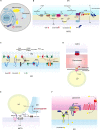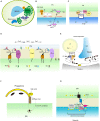Lipid Metabolism at Membrane Contacts: Dynamics and Functions Beyond Lipid Homeostasis
- PMID: 33425923
- PMCID: PMC7786193
- DOI: 10.3389/fcell.2020.615856
Lipid Metabolism at Membrane Contacts: Dynamics and Functions Beyond Lipid Homeostasis
Abstract
Membrane contact sites (MCSs), regions where the membranes of two organelles are closely apposed, play critical roles in inter-organelle communication, such as lipid trafficking, intracellular signaling, and organelle biogenesis and division. First identified as "fraction X" in the early 90s, MCSs are now widely recognized to facilitate local lipid synthesis and inter-organelle lipid transfer, which are important for maintaining cellular lipid homeostasis. In this review, we discuss lipid metabolism and related cellular and physiological functions in MCSs. We start with the characteristics of lipid synthesis and breakdown at MCSs. Then we focus on proteins involved in lipid synthesis and turnover at these sites. Lastly, we summarize the cellular function of lipid metabolism at MCSs beyond mere lipid homeostasis, including the physiological meaning and relevance of MCSs regarding systemic lipid metabolism. This article is part of an article collection entitled: Coupling and Uncoupling: Dynamic Control of Membrane Contacts.
Keywords: lipid biosynthesis; lipid composition; lipid degradation; lipid functions; membrane contact site.
Copyright © 2020 Xu and Huang.
Conflict of interest statement
The authors declare that the research was conducted in the absence of any commercial or financial relationships that could be construed as a potential conflict of interest.
Figures


Similar articles
-
Membrane contact sites, gateways for lipid homeostasis.Curr Opin Cell Biol. 2015 Apr;33:82-87. doi: 10.1016/j.ceb.2014.12.004. Epub 2015 Jan 6. Curr Opin Cell Biol. 2015. PMID: 25569848 Free PMC article. Review.
-
Membrane contact sites, ancient and central hubs of cellular lipid logistics.Biochim Biophys Acta Mol Cell Res. 2017 Sep;1864(9):1450-1458. doi: 10.1016/j.bbamcr.2017.05.017. Epub 2017 May 26. Biochim Biophys Acta Mol Cell Res. 2017. PMID: 28554771 Review.
-
Mechanisms of Non-Vesicular Exchange of Lipids at Membrane Contact Sites: Of Shuttles, Tunnels and, Funnels.Front Cell Dev Biol. 2021 Nov 29;9:784367. doi: 10.3389/fcell.2021.784367. eCollection 2021. Front Cell Dev Biol. 2021. PMID: 34912813 Free PMC article. Review.
-
A molecular toolbox for interrogation of membrane contact sites.J Physiol. 2020 May;598(9):1725-1739. doi: 10.1113/JP277761. Epub 2019 Jun 11. J Physiol. 2020. PMID: 31119749 Free PMC article. Review.
-
The formation and function of ER-endosome membrane contact sites.Biochim Biophys Acta. 2016 Aug;1861(8 Pt B):874-879. doi: 10.1016/j.bbalip.2016.01.020. Epub 2016 Feb 16. Biochim Biophys Acta. 2016. PMID: 26898183 Free PMC article. Review.
Cited by
-
Effects of Aging and Disease Conditions in Brain of Tumor-Bearing Mice: Evaluation of Purine DNA Damages and Fatty Acid Pool Changes.Biomolecules. 2022 Aug 4;12(8):1075. doi: 10.3390/biom12081075. Biomolecules. 2022. PMID: 36008969 Free PMC article.
-
EMC1 Is Required for the Sarcoplasmic Reticulum and Mitochondrial Functions in the Drosophila Muscle.Biomolecules. 2024 Oct 5;14(10):1258. doi: 10.3390/biom14101258. Biomolecules. 2024. PMID: 39456191 Free PMC article.
-
The Chemical Reactivity of Membrane Lipids.Chem Rev. 2024 Mar 27;124(6):3284-3330. doi: 10.1021/acs.chemrev.3c00608. Epub 2024 Mar 18. Chem Rev. 2024. PMID: 38498932 Free PMC article. Review.
-
Diacylglycerol metabolism and homeostasis in fungal physiology.FEMS Yeast Res. 2024 Jan 9;24:foae036. doi: 10.1093/femsyr/foae036. FEMS Yeast Res. 2024. PMID: 39611318 Free PMC article. Review.
-
Dysregulation of cellular membrane homeostasis as a crucial modulator of cancer risk.FEBS J. 2024 Apr;291(7):1299-1352. doi: 10.1111/febs.16665. Epub 2022 Nov 7. FEBS J. 2024. PMID: 36282100 Free PMC article. Review.
References
-
- Achleitner G., Gaigg B., Krasser A., Kainersdorfer E., Kohlwein S. D., Perktold A., et al. (1999). Association between the endoplasmic reticulum and mitochondria of yeast facilitates interorganelle transport of phospholipids through membrane contact. Eur. J. Biochem. 264 545–553. 10.1046/j.1432-1327.1999.00658.x - DOI - PubMed
-
- Agranoff B. W., Bradley R. M., Brady R. O. (1958). The enzymatic synthesis of inositol phosphatide. J. Biol. Chem. 233 1077–1083. - PubMed
-
- Antonicka H., Lin Z. Y., Janer A., Aaltonen M. J., Weraarpachai W., Gingras A. C., et al. (2020). A high-density human mitochondrial proximity interaction network. Cell Metab. 32 479–497.e9. - PubMed
Publication types
LinkOut - more resources
Full Text Sources

